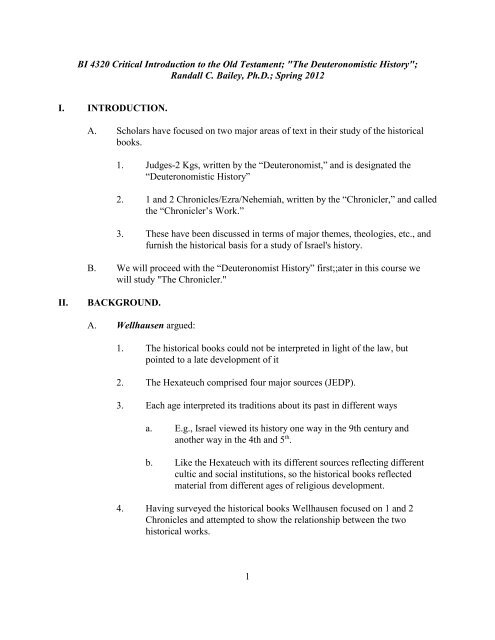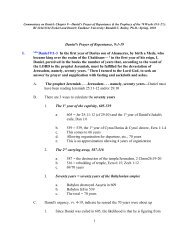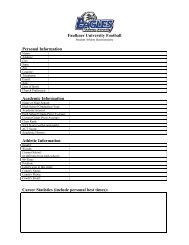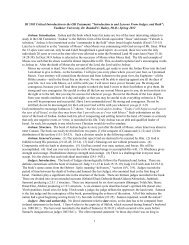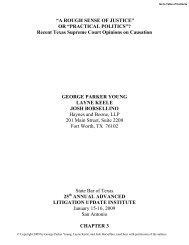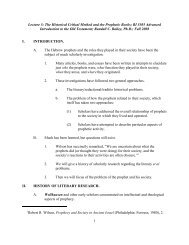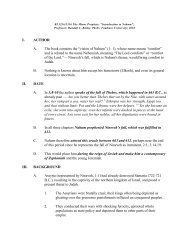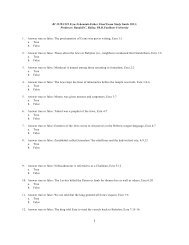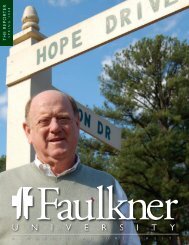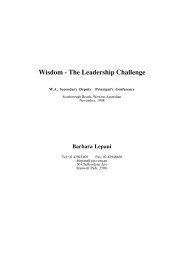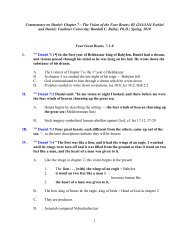06 The Deuteronomistic History - Faulkner University - Home
06 The Deuteronomistic History - Faulkner University - Home
06 The Deuteronomistic History - Faulkner University - Home
You also want an ePaper? Increase the reach of your titles
YUMPU automatically turns print PDFs into web optimized ePapers that Google loves.
BI 4320 Critical Introduction to the Old Testament; "<strong>The</strong> <strong>Deuteronomistic</strong> <strong>History</strong>";<br />
Randall C. Bailey, Ph.D.; Spring 2012<br />
I. INTRODUCTION.<br />
A. Scholars have focused on two major areas of text in their study of the historical<br />
books.<br />
1. Judges-2 Kgs, written by the “Deuteronomist,” and is designated the<br />
“<strong>Deuteronomistic</strong> <strong>History</strong>”<br />
2. 1 and 2 Chronicles/Ezra/Nehemiah, written by the “Chronicler,” and called<br />
the “Chronicler’s Work.”<br />
3. <strong>The</strong>se have been discussed in terms of major themes, theologies, etc., and<br />
furnish the historical basis for a study of Israel's history.<br />
B. We will proceed with the “Deuteronomist <strong>History</strong>” first;;ater in this course we<br />
will study "<strong>The</strong> Chronicler."<br />
II. BACKGROUND.<br />
A. Wellhausen argued:<br />
1. <strong>The</strong> historical books could not be interpreted in light of the law, but<br />
pointed to a late development of it<br />
2. <strong>The</strong> Hexateuch comprised four major sources (JEDP).<br />
3. Each age interpreted its traditions about its past in different ways<br />
a. E.g., Israel viewed its history one way in the 9th century and<br />
th<br />
another way in the 4th and 5 .<br />
b. Like the Hexateuch with its different sources reflecting different<br />
cultic and social institutions, so the historical books reflected<br />
material from different ages of religious development.<br />
4. Having surveyed the historical books Wellhausen focused on 1 and 2<br />
Chronicles and attempted to show the relationship between the two<br />
historical works.<br />
1
BI 4320 Critical Introduction to the Old Testament; "<strong>The</strong> <strong>Deuteronomistic</strong> <strong>History</strong>";<br />
Randall C. Bailey, Ph.D.; Spring 2012<br />
1<br />
Ronald E. Clements, One Hundred Years of Old Testament Interpretation (Philadelphia:<br />
Westminster, 1976), 33.<br />
2Clements,<br />
One Hundred Years, 33.<br />
a. He argued that Judges-2 Kings served as the basis for the<br />
Chronicler's work, which included 1 and 2 Chronicles, Ezra, and<br />
Nehemiah.<br />
b. While Judges-2 Kings was dated in the Babylonian Exile and<br />
contained the theological views of that day, the Chronicler’s work<br />
came after the fall of Persia and reflected those theological views.<br />
c. This allowed Wellhausen to show:<br />
. . . not only in the case of the Chronicler but also in Judges,<br />
Samuel and Kings, that the views and distinctive religious ideals of<br />
a particular age have been impressed on the earlier sources. In the<br />
case of the Chronicler's history these were the ideals of the Persian<br />
period, but in Judges, 1 and 2 Samuel and 1 and 2 Kings the ideals<br />
were those that had arisen in the Babylonian exile which bore<br />
strong affinity with the ideas and aims to be found in the book of<br />
Deuteronomy. 1<br />
5. <strong>The</strong> way to get at the earlier source material was by identifying and setting<br />
aside this later redactional material.<br />
6. This done “it was clear that a considerable variety of documents had been<br />
used, and this was further borne out by the fact that the books of Kings<br />
refer explicitly to a number of sources which were evidently available in<br />
documentary form.” 2<br />
a. Cf. Josh 10:13: “Book of Jashar”<br />
b. <strong>The</strong> author of Joshua is citing a source<br />
7. <strong>The</strong> race was on to trace the sources in the historical books<br />
(Joshua[Judges]-2 Kings) in much the same manner that had been done in<br />
the Pentateuch/Hexateuch.<br />
2
BI 4320 Critical Introduction to the Old Testament; "<strong>The</strong> <strong>Deuteronomistic</strong> <strong>History</strong>";<br />
Randall C. Bailey, Ph.D.; Spring 2012<br />
B. Karl Budde: “. . . argued that much of the source material [in the Historical<br />
Books] has been drawn from the same J and E sources as are to be found in the<br />
Hexateuch.” 3<br />
1. This meant that JEDP should also be considered as major sources for the<br />
historical books, along with other source material.<br />
2. Budde went beyond Wellhausen, claiming “. . . that the new literary<br />
criticism could solve the problem of the sources of the remaining books of<br />
the Former Prophets (Judges to 2 Kings). Such a view was taken up by<br />
other scholars, notably O. Eissfeldt in a study of the sources of the books<br />
of Judges and 1 and 2 Samuel and from this has obtained a wide currency<br />
in the study of the Old Testament.” 4<br />
3. <strong>The</strong> results of such attempts to locate sources in the historical books, have<br />
been so illusive in that scholarship has failed “. . . to reach a conclusion<br />
that has been as generally convincing to scholarship as was the case with<br />
the Hexateuch. It is only an assumption that the J and E documents can be<br />
traced in these other books, since it has not been possible to establish<br />
positive arguments in favour of such identification.” 5<br />
C. Gressmann refined Gunkel’s methods.<br />
1. He argued that scholars would have greater success if they would focus on<br />
the individual narratives themselves.<br />
2. This adaptation of Gunkel’s Gattungsgeschichtliche method in<br />
Pentateuchal criticism, produced new questions regarding Israel's<br />
conquest, to which Alt made a major contribution.<br />
D. Albrecht Alt focused on the discrepancy between Joshua and Judges-1 Samuel in<br />
regard to Israel’s settlement in Canaan.<br />
1. <strong>The</strong> problem:<br />
3<br />
Clements, One Hundred Years, 34.<br />
4Clements,<br />
One Hundred Years, 34.<br />
5Clements,<br />
One Hundred Years, 35.<br />
3
BI 4320 Critical Introduction to the Old Testament; "<strong>The</strong> <strong>Deuteronomistic</strong> <strong>History</strong>";<br />
Randall C. Bailey, Ph.D.; Spring 2012<br />
6Clements,<br />
One Hundred Years, 37.<br />
a. Joshua records Israel’s “lightning like” conquest of certain major<br />
areas, Josh 10:29-13:1<br />
b. But Judges-1 Samuel indicate that the people had to share the land<br />
with various other people for some time, Judg 1:27-2:5.<br />
c. Several scholars attacked this problem, including C. F. Burney, J.<br />
Garstang, H. H. Rowley, etc.<br />
d. (None of these scholars ever raised the problem of definition in<br />
regard to the terms “conquest” and “migration.” E.g., was the<br />
“settling” of this country, which involved the displacement of the<br />
American Indian, a conquest or a migration?)<br />
2. Alt employed a “historico-geographical” method in which geographical<br />
features (climate and topography) are used to “establish a given range of<br />
possibilities for the economy and communications of a region,” with the<br />
result that this information “can provide invaluable evidence regarding the<br />
background of events.” 6<br />
3. He “. . . argued that the monarchy arose in Israel as a dual institution,<br />
binding together in the person of the one Davidic king the two kingdoms<br />
of Israel and Judah. <strong>The</strong>se had originally existed as separate tribal<br />
associations, and reverted to this separateness under Rehoboam.”<br />
4. In 1925, using new archaeological data, Alt refined his theory:<br />
. . . small Canaanite city-states, under Egyptian hegemony, with other<br />
population elements spread throughout the rural areas and partially<br />
controlled by the rulers of the cities. <strong>The</strong>se were of mixed character, and<br />
made up largely of sheep-farming, bedouin, who moved their pastures<br />
with the changing seasons. <strong>The</strong> evidence showed a steady and prolonged<br />
migration of such people from further east into the settled Palestinian land.<br />
. . . this prolonged settlement of such sheep-farming bedouin in Canaan . . .<br />
came retrospectively to be viewed as a conquest of the land. <strong>The</strong> event of<br />
the occupation of the land was not a concentrated and planned invasion,<br />
4
BI 4320 Critical Introduction to the Old Testament; "<strong>The</strong> <strong>Deuteronomistic</strong> <strong>History</strong>";<br />
Randall C. Bailey, Ph.D.; Spring 2012<br />
7<br />
Clements, One Hundred Years, 38.<br />
8<br />
An “amphictyony” may be defined as “an association of neighboring states or tribes in<br />
ancient Greece originally established to defend a common religious center and later developing<br />
into a league with certain legislative and judicial functions”; generally, “any association of<br />
neighboring states banded together for their common protection and interest.”<br />
9Clements,<br />
One Hundred Years, 40.<br />
which could be ascribed to one particular date, but the piecemeal taking<br />
over of thinly inhabited territory. 7<br />
5. Alt was comparing Israel’s early tribal organization to that of Greek and<br />
Italian communities and arguing that just as these early groups existed in<br />
8<br />
amphictyonies, so early tribes of Israel were bound by the common<br />
worship of Yhwh.<br />
E. Research in the historical books had now formed two different areas of study.<br />
1. Alt’s historico-geographical method (as further developed by his student,<br />
Martin Noth) proved to be the foundation of all future discussions.<br />
2. <strong>The</strong> form critical method of examining the individual narrative units, to<br />
which we now return.<br />
F. Scholars began to notice the connected nature of the various narratives.<br />
1. Wellhausen had pointed to the interconnectedness of the narratives of<br />
intrigue and rebellion in David’s court.<br />
2. L. Rost (1926) designated 2 Samuel 9-20 a “"Succession Narrative,”"<br />
since it told of Solomon's succession to the throne. He argued:<br />
a. This narrative continued to 1 Kings 3.<br />
b. We should recognize in the various narrative segments of this<br />
passage “the overall redactional purpose which they had been made<br />
to serve.” 9<br />
5
BI 4320 Critical Introduction to the Old Testament; "<strong>The</strong> <strong>Deuteronomistic</strong> <strong>History</strong>";<br />
Randall C. Bailey, Ph.D.; Spring 2012<br />
3. Scholarship began arguing for an interweaving of various documentary<br />
sources along the lines of what they had argued for the Pentateuch.<br />
4. More and more emphasis was being placed on:<br />
a. Individuals<br />
10Clements,<br />
One Hundred Years, 42.<br />
11Clements,<br />
One Hundred Years, 43.<br />
b. How the various narrative units had been put together<br />
c. <strong>The</strong> theological perspectives of each one.<br />
5. <strong>The</strong> various historical books were being seen as religious books with<br />
theological purposes.<br />
6. This was the beginning of redactional criticism which set the stage for<br />
Martin Noth and the <strong>Deuteronomistic</strong> <strong>History</strong>.<br />
G. Noth built upon Alt’s amphictyony theory and connected it with the new<br />
redactional/traditio-criticism.<br />
1. He “saw a close relationship between Israel’s organization as an<br />
amphictyony and its distinctive traditions of law.” 10<br />
2. <strong>The</strong> central officer of the tribal union was the law-speaker “who was<br />
responsible for ensuring that the legal and ethical demands of the worship<br />
of...God were accepted by all the member tribes.” 11<br />
3. Out of this tribal union grew specific traditions, all of which reflected the<br />
tribal relationship of mutual obligation to worship the same God.<br />
4. But in none of these traditions, or narrative segments, could be found any<br />
evidence that they once belonged to J or E.<br />
5. Noth was now arguing that no Pentateuchal sources could be found in<br />
Joshua at all.<br />
6
7.<br />
BI 4320 Critical Introduction to the Old Testament; "<strong>The</strong> <strong>Deuteronomistic</strong> <strong>History</strong>";<br />
Randall C. Bailey, Ph.D.; Spring 2012<br />
6. In 1943 Noth articulated an alternative to the usual view of Joshua to 2<br />
Kings.<br />
12<br />
Clements, One Hundred Years, 44.<br />
. . . these books were not separate compositions, but rather formed one<br />
continuous <strong>Deuteronomistic</strong> <strong>History</strong> which began with the law book of<br />
Deuteronomy and extended to the end of 2 Kings. This is why in the work<br />
the law of Deuteronomy is regarded as expressing the divine will by which<br />
the subsequent account of the rise and fall of Israel is judged and<br />
interpreted. Deuteronomy 1-3 had been composed as the historical preface<br />
to this major piece of history-writing. Subsequently some additions had<br />
been made, notably in Judges 1, Joshua 13-19 and Joshua 24. 12<br />
7. This was the culmination of scholarly research that had begun 50 years<br />
before.<br />
III. BASIC CHARACTERISTICS.<br />
a. Noth's hypothesis has been so influential, that nearly all<br />
scholarship has embraced a version of the theory.<br />
b. We need to be even more familiar with it than the Documentary<br />
Hypothesis.<br />
A. General definition: <strong>The</strong> “Deuteronomist (ic <strong>History</strong>)” is the title given to the<br />
body of literature from Deut-2 Kings by the OT scholar Martin Noth. In 1943<br />
Noth hypothesized that Deut-2 Kings was written by a single author, living in<br />
Israel during the Exile. This author/editor/compiler made use of earlier oral and<br />
written traditions in order to produce his work. <strong>The</strong> history was expanded through<br />
secondary additions by later redactors who belonged to a “<strong>Deuteronomistic</strong><br />
School.” Noth’s theory disputed an older view which saw the Hexateuch<br />
(Genesis -Judges 1 as a work added to by the Deuteronomist. Further, Noth’s<br />
theory denied any relationship between Genesis-Numbers and the DH. Noth’s<br />
theory has been vigorously defended and rejected, with both sides making<br />
revisions in the theory proper in order to produce a different “version” of the<br />
classical theory. 13<br />
13Richard<br />
N. Soulen, Handbook of Biblical Criticism, 3d ed. (Atlanta: John Knox, 2001), 46-<br />
7
BI 4320 Critical Introduction to the Old Testament; "<strong>The</strong> <strong>Deuteronomistic</strong> <strong>History</strong>";<br />
Randall C. Bailey, Ph.D.; Spring 2012<br />
B. Deuteronomy is perceived as the introduction to the <strong>Deuteronomistic</strong> <strong>History</strong><br />
(DH).<br />
C. <strong>The</strong> anti-monarchic polemic of Deut 17:14-20 and rise of monarchy where the<br />
people request a king in 1 Sam 8.<br />
D. Jerusalem only as the place of worship (Deut 12:1-14) and Josiah's reform (2 Kgs<br />
22-23).<br />
E. If Moses is the supreme prophet (Deut 18) then:<br />
1. <strong>The</strong>re follows a succession of prophets in his tradition, Elijah and Elisha,<br />
etc.<br />
2. <strong>The</strong> use of a prediction-and-fulfillment scheme seen through out the work<br />
(2 Sam 7:12-13 and 1 Kgs 8:20; 1 Kgs 11:30-31 and 12:15-16; 1 Kgs<br />
14:7f and 15:27-28; 1 Kgs 16:1-4 and 16:9-14) serves to indicate that<br />
these prophets were prophets like Moses in that their words have been<br />
fulfilled.<br />
3. <strong>The</strong> phrase “my/his/your servants the prophets” attempts to connect the<br />
succession of prophets as "servants" like the "servant" Moses.<br />
IV. THE CLASSIC THEORY.<br />
14<br />
A. Noth’s theory may be summarized as follows.<br />
1. He described the DH as a unity composed by a single author who had a<br />
15<br />
definite plan, which is evidenced by the following:<br />
14<br />
Martin Noth, Überlieferungsgeschichtliche Studien, 2d ed. (Tübingen: Max Niemeyer, 1957;<br />
3d ed. unaltered, 1967) = <strong>The</strong> <strong>Deuteronomistic</strong> <strong>History</strong>, JSOTS 15 (1981): 1-153.<br />
15Noth,<br />
<strong>The</strong> <strong>Deuteronomistic</strong> <strong>History</strong>, 6.<br />
8
BI 4320 Critical Introduction to the Old Testament; "<strong>The</strong> <strong>Deuteronomistic</strong> <strong>History</strong>";<br />
Randall C. Bailey, Ph.D.; Spring 2012<br />
a. “Deut. 1-3 is not the introduction to the Deuteronomic law but the<br />
beginning of the <strong>Deuteronomistic</strong> historical narrative" which "is<br />
selected to supply the needs of the Dtr.'s work.” 16<br />
b. <strong>The</strong> Dtr. showed an express interest in chronology and the relating<br />
of events to each other, e.g., 1 Kgs 6:1 and the Exodus.<br />
c. He introduced key speeches at key points (Jos 12; 23; 1 Sam 12; 1<br />
Kgs 8:14ff).<br />
d. In his selection and presentation of the material the historian<br />
allowed the sources to “speak for themselves”:<br />
16<br />
Noth, <strong>The</strong> <strong>Deuteronomistic</strong> <strong>History</strong>, 14.<br />
Dtr. had no intention of fabricating the history of the Israelite<br />
people. He wished to present it objectively and base it upon the<br />
material to which he had access. Like and honest broker he began<br />
by taking, in principle, a favourable view of the material in the<br />
traditions. In describing the various historical events he spoke in<br />
his own person only at certain exceptional points, letting the old<br />
traditions speak for themselves. 17<br />
e. Central theological ideas pointed to the unity of the work.<br />
Dtr. did not write his history to provide entertainment in hours of<br />
leisure or to satisfy a curiosity about national history, but intended<br />
it to teach the true meaning of the history of Israel from the<br />
occupation to the destruction of the old order. <strong>The</strong> meaning which<br />
he discovered was that God was recognizably at work in this<br />
history, continuously meeting the accelerating moral decline with<br />
warnings and punishments and finally, when these proved fruitless<br />
with total annihilation. Dtr., then, perceives a just divine<br />
retribution in the history of the people, though not so much (as yet)<br />
in the fate of the individual. He sees this as the great unifying<br />
factor in the course of events, and speaks of it not in general terms<br />
but in relation to the countless specific details reported in the<br />
17Noth,<br />
<strong>The</strong> Deuteronimistic <strong>History</strong>, 84. See also, Baruch Halpern, <strong>The</strong> First Historians: <strong>The</strong><br />
Hebrew Bible and <strong>History</strong> (San Francisco: Harper & Row, 1988), 30-31.<br />
9
BI 4320 Critical Introduction to the Old Testament; "<strong>The</strong> <strong>Deuteronomistic</strong> <strong>History</strong>";<br />
Randall C. Bailey, Ph.D.; Spring 2012<br />
18<br />
Noth, <strong>The</strong> <strong>Deuteronomistic</strong> <strong>History</strong>, 89.<br />
19<br />
Noth, <strong>The</strong> <strong>Deuteronomistic</strong> <strong>History</strong>, 26-74.<br />
20D.<br />
N. Freedman, “Deuternomic <strong>History</strong>, <strong>The</strong>.” IDBSupp (1976): 226b.<br />
21Noth,<br />
<strong>The</strong> <strong>Deuteronomistic</strong> <strong>History</strong>, 10.<br />
extant traditions. Thus Dtr. approached his work with a definite<br />
theological conviction. 18<br />
f. <strong>The</strong> DH is composed of 5 major sections. 19<br />
(1) Section 1: the Dtr provided the original book of<br />
Deuteronomy with an introduction (Deut 1-3 belong to DH;<br />
4:1-40 to PHEd) and various epilogues (27, 29-34) which<br />
deal “with the nature of Israel's relationship to Yahweh,<br />
consistently emphasizing a program of one God, one<br />
people, one cult.” 20<br />
(2) Section 2: Joshua describes the conquest of Canaan, the<br />
fulfillment of the covenantal promises and the themes of<br />
the Exodus and the Conquest anticipated in Judg 5.<br />
(3) Section 3: Judges-1 Sam 7 describe the problems of premonarchic<br />
Israel and provide the most evidence of the Dtr's<br />
theology.<br />
(4) Section 4: 1 Sam 7-1 Kgs 8 records the rise of the<br />
monarchy.<br />
(5) Section 5: 1 Kgs 9-2 Kgs 23:25 records the decline of the<br />
divided monarchy. <strong>The</strong> Dtr's hand is seen most clearly here<br />
in the evaluation of each king.<br />
(6) In sections other than 3 and 5 this editor incorporated older<br />
material, either in pristine or edited form.<br />
2. Noth’s theory presupposed two things. 21<br />
10
BI 4320 Critical Introduction to the Old Testament; "<strong>The</strong> <strong>Deuteronomistic</strong> <strong>History</strong>";<br />
Randall C. Bailey, Ph.D.; Spring 2012<br />
22<br />
Gerard von Rad, Old Testament <strong>The</strong>ology, 2 vols. Translated by D. M. G. Stalker (New<br />
York: Harper and Row, 1962-65): 1:346ff.<br />
23Gwelyn<br />
H. Jones. 1 and 2 Kings, 2 vols. (Grand Rapids: Eerdmans, 1984), 1:38.<br />
24Jones,<br />
Kings, 1:38-9.<br />
a. <strong>The</strong> DH part of a larger primary history (PH) which extends from<br />
Genesis to 2 Kings and which was completed ca. 550 BC.<br />
b. Pentateuchal sources could not be traced beyond Genesis-<br />
Numbers.<br />
B. But scholars have perceived several problems with this theory.<br />
V. SOME OF THE MORE SIGNIFICANT PROBLEMS:<br />
22<br />
A. Von Rad was not convinced that the same author could have authored Judges<br />
and Kings because these two books represent different methodologies. Jones<br />
summarizes:<br />
Whereas Judges works with a cyclical outline of history, there is complete<br />
absence of cycles from Kings; the historian consistently sits in judgment on the<br />
kings, but not on the judges; in Judges there is a distinction between the attitude<br />
of the people and their judges, but in Kings the people and kings are coupled<br />
together in the guilt caused by the kings; history in the period of the kings, was<br />
directed by the creative word of God, but in Judges by the charisma of the<br />
judges. 23<br />
B. But scholars are divided on this issue.<br />
. . . the cycles in Judges are not the work of the deuteronomistic historian, thus<br />
canceling many of the differences. When a closer analysis of historical patterns is<br />
undertaken, the ones in Judges and Kings are found to be the same (Trompf, VTS<br />
30 [1979], pp. 219-24). Consequently, Nelson (op. cit., p. 14) has not been<br />
impressed by von Rad's attempt to dissolve the deuteronomistic historian; he has<br />
not been convinced either by Weiser’s suggestion (Samuel, pp. 25ff.) that since<br />
the antimonarchical attitude of 1 Samuel is not shared by Deuteronomy or Kings<br />
the complex cannot have originated from the same author. 24<br />
11
BI 4320 Critical Introduction to the Old Testament; "<strong>The</strong> <strong>Deuteronomistic</strong> <strong>History</strong>";<br />
Randall C. Bailey, Ph.D.; Spring 2012<br />
C. Scholars are also divided relative to the literary analysis of the work.<br />
25<br />
G. Fohrer, Introduction to the Old Testament (London: 1970), 194ff; cf. Jones, Kings, 1:39.<br />
26<br />
J. R. Porter, “Old Testament Historiography,” in Tradition and Interpretation, G. W.<br />
Anderson, ed. (Oxford: Clarendon, 1979), 137.<br />
27Jones,<br />
Kings, 1:39-40.<br />
1. <strong>The</strong>y assert that Noth’s view is far to simple.<br />
25<br />
a. Fohrer has argued that the DH is collection of books composed<br />
and produced in different ways, thus rejecting Noth's argument of a<br />
unified historical work.<br />
b. But Porter has argued that this can be accounted for on the basis of<br />
the diverse nature of the material available to the historian. 26<br />
2. Scholars have also seen supposed tensions between the book of<br />
Deuteronomy and the DH: 27<br />
a. “<strong>The</strong> tension felt between the amphictyonic and Mosaic traditions<br />
of Deuteronomy and the Davidic and Jerusalemite traditions of the<br />
<strong>Deuteronomistic</strong> <strong>History</strong>.”<br />
b. “<strong>The</strong> tension between the deuteronomistic aim of presenting a<br />
theological interpretation of history and the faithfulness of the<br />
deuteronomists in transmitting the material which they had<br />
received.”<br />
c. “Inevitably, the acceptance of this latter principle led to the<br />
inclusion of some material that did not always accord with the<br />
historian’s aim and purpose.”<br />
3. Scholars’ attempts at reconciling these tensions only raised more<br />
problems.<br />
Noth excised such sections and regarded them as latter additions. But it<br />
must be asked whether the bringing out of the dominant theological<br />
interpretation in some sections, and the inclusion of some passages that do<br />
12
BI 4320 Critical Introduction to the Old Testament; "<strong>The</strong> <strong>Deuteronomistic</strong> <strong>History</strong>";<br />
Randall C. Bailey, Ph.D.; Spring 2012<br />
28<br />
Jones, Kings, 1:40.<br />
not contribute to the main theme, point ultimately to the activity of<br />
different groups or different editors. . . . 28<br />
4. This raises the question of two or more editors, or two or more<br />
redactions. 29<br />
30<br />
D. <strong>The</strong> single (Noth), double redaction (Richard Nelson), and multiple redaction<br />
(“<strong>Deuteronomistic</strong> Circle”) theories. 31<br />
1. A single redaction: Noth’s hypothesis and the problems scholars have<br />
found with it have already been noted.<br />
2. A double redaction: two theories<br />
a. A pre-exilic and an exilic redaction:<br />
(1) <strong>The</strong>re are passages in Kings which presuppose the fall of<br />
Jerusalem and the Exile (e.g. 1 Kg. 5:4; 9:1-9; 11:9-13; 2<br />
Kg. 17:19-20; 20:17-18; 21:11-15; 22:15-20; 23:26-27;<br />
24:2-4; 24:18-25:30). 32<br />
(2) Other passages are totally unaware of the Exile:<br />
(a) <strong>The</strong> use of the formula “unto this day” would be<br />
inappropriate in some passages if the author had<br />
29<br />
Cf. Raymond B. Dillard and Tremper Longmann, III, An Introduction to the Old Testament<br />
(Grand Rapids: Zondervan, 1994), 122-23.<br />
30<br />
Richard D. Nelson. <strong>The</strong> Double Redaction of the <strong>Deuteronomistic</strong> <strong>History</strong>, JSOTS 18<br />
(1981): 1-185.<br />
31<br />
R. Smend. “Das Gesetz und die Völker: Ein Beitrag zur deuteronomistischen<br />
Redaktionsgeschichte.” In Probleme Biblischer <strong>The</strong>ologie, Festschsrift von Rad, pp.494-509.<br />
Edited by H. W. Wolff (Munich, 1971).<br />
32<br />
Many of these passages are interpreted as being post-exilic due to the presupposition that<br />
there is no predictive prophecy. Italicized passages are legitimate. <strong>The</strong> pertinent question is,<br />
“Why was the passage written?”<br />
13
BI 4320 Critical Introduction to the Old Testament; "<strong>The</strong> <strong>Deuteronomistic</strong> <strong>History</strong>";<br />
Randall C. Bailey, Ph.D.; Spring 2012<br />
33<br />
Jones, Kings, 1:32-3.<br />
34<br />
Jones, Kings, 1:31. Cf. previous passages to 2 Kgs 25:13.<br />
35<br />
F. M. Cross, “<strong>The</strong> <strong>The</strong>mes of the Book of Kings and the Structure of the Deuteronomic<br />
<strong>History</strong>,” Canaanite Myth and Hebrew Epic (Cambridge, Mass.: Cambridge, 1973), 274-89.<br />
36Jones,<br />
Kings, 1:31-2.<br />
been writing at any time after the disaster of 587<br />
BC.<br />
(b) Cf. Josh 7:26; 1 Kgs 8:8; 10:12; 12:19; 2 Kgs 8:22;<br />
10:27; 16:6; 17:23; 20:17; 21:15<br />
(3) Again some passages take the continuing existence of the<br />
Davidic dynasty for granted, as indeed that of the Jerusalem<br />
Temple.<br />
(4) Sections which Noth claimed were editorial comments<br />
Nelson argues actually belong to an exilic editor. 33<br />
(5) “Thus, it has been argued, a pre-exilic, deuteronomistic<br />
work dated c. 600 BC was reworked and expanded in the<br />
Babylonian exile (so Kuenen, Einleitung I, pp. 88-100; see<br />
also Nelson, Double Redaction, pp. 14ff., for reference to<br />
other forms of the double redaction hypothesis, and cf.<br />
Radjawane, Thr 38 [1974], pp. 177-216).” 34<br />
35<br />
b. Cross modified the double redaction hypothesis.<br />
<strong>The</strong> first redaction is dated in the reign of Josiah and interpreted as<br />
a piece of propaganda for Josiah’s policies. Around 560 BC the<br />
original work was brought up to date through the insertion of a<br />
number of additions, which changed the theological emphasis of<br />
the work as a whole. 36<br />
(1) <strong>The</strong>re seems to be a change in the structure of the history in<br />
the last chapters of Kings:<br />
14
BI 4320 Critical Introduction to the Old Testament; "<strong>The</strong> <strong>Deuteronomistic</strong> <strong>History</strong>";<br />
Randall C. Bailey, Ph.D.; Spring 2012<br />
37Jones<br />
Kings, 1:34.<br />
38 2<br />
A. Jepsen, Die Quellen des Köingsbücher, Halle, 1956 .<br />
(a) <strong>The</strong> disappearance of sermon or comment on<br />
significant historical event (e.g, an absence of a<br />
comment on the fall of Judah which is similar to the<br />
one offered for the fall of Samaria).<br />
(b) A change in the prophecy-fulfillment scheme (e.g.,<br />
2 Kgs 21:10-15; 24:2 predicts the punishment of<br />
Manasseh without mentioning the prophet's name).<br />
(2) <strong>The</strong> original history should be dated in Josiah's time<br />
because Josiah is regarded as the new David (2 Kgs 23:25)<br />
and such a view would be inappropriate in exilic times.<br />
(3) Different theological perspectives evidenced in the work.<br />
(a) <strong>The</strong> pre-exilic history, written in Josiah’s time,<br />
exhibits two common themes: the sin of Jeroboam<br />
and the promise to David which reached its climax<br />
in Josiah.<br />
(b) <strong>The</strong> exilic editor had a different perspective: “He<br />
saw inevitable punishment for the sins of Manasseh,<br />
and...introduces a theological motif that is out of<br />
tune with the rest of the history.” 37<br />
(c) <strong>The</strong>se differences point to two different editors: preexilic<br />
and exilic.<br />
3. <strong>The</strong> theory of a Deuteronomic School was proposed because the double<br />
redaction theory was deemed too simple; it did not account for all the<br />
facts.<br />
38<br />
a. Jepsen proposed that the history was the result of gradual growth<br />
worked on by several different people.<br />
(1) <strong>The</strong>re was no theological motive behind this work.<br />
15
BI 4320 Critical Introduction to the Old Testament; "<strong>The</strong> <strong>Deuteronomistic</strong> <strong>History</strong>";<br />
Randall C. Bailey, Ph.D.; Spring 2012<br />
39<br />
Smend, "Das Gesetz," 494-509.<br />
40Jones,<br />
Kings, 1:43.<br />
41Jones,<br />
Kings, 1:44.<br />
(2) Its only purpose was to contrast the Davidic dynasty with<br />
the northern kingdom.<br />
(3) <strong>The</strong> basis for this document was the chronicle of 1 Kgs<br />
2:10-2 Kgs 18:8.<br />
(4) Most of this theory has been rejected due to perceived<br />
problems in the supposed “chronicle.”<br />
39<br />
b. Smend refined Jepsen’s theory by proposing three layers of<br />
deuteronomistic tradition:<br />
First of all came the basic historical work (DtrH), then followed a<br />
redaction which introduced prophetical texts (DtrP), and finally,<br />
law-oriented additions were included (DtrN). It is argued that the<br />
three layers were deuteronomistic and that the designation of the<br />
final redaction as nomistic does not preclude DtrH and DtrP from<br />
being called deuteronomistic. 40<br />
c. This theory “succeeds in reconciling the two main methods<br />
adopted by previous researchers, the one represented by Noth and<br />
the other by Jepsen.” 41<br />
(1) Noth’s contention, that the <strong>Deuteronomistic</strong> <strong>History</strong> is a<br />
unified work, is preserved in the argument that all three<br />
versions were basically deuteronomistic.<br />
(2) Full recognition is given to the unified ideological outlook<br />
and to the working presuppositions of the deuteronomic<br />
school.<br />
(3) By maintaining that the work is the result of continuous<br />
activity by that school, which worked at the basic material<br />
16
BI 4320 Critical Introduction to the Old Testament; "<strong>The</strong> <strong>Deuteronomistic</strong> <strong>History</strong>";<br />
Randall C. Bailey, Ph.D.; Spring 2012<br />
and brought out more explicitly certain emphases, we<br />
recognize that different redactions were made, without<br />
falling into the pitfalls of Jepsen's analysis of those<br />
redactions.<br />
(4) <strong>The</strong> concept of continuing activity by a deuteronomic<br />
school gives an adequate account of the unity and the<br />
diversity of the body of literature.<br />
(5) Keep in mind however this is only a synthesis of two<br />
theories in an attempt to use the “best” of differing theories;<br />
can truth obtained this way?<br />
E. Rendtorff believes that the influence of the “<strong>Deuteronomistic</strong> Circle,” or “School”<br />
“lies in a wider context.” 42<br />
1. This would include “many other areas of the Old Testament literature,”<br />
including the “Pentateuch . . . the prophetic books, psalms and so on.”<br />
2. <strong>The</strong> “circle,” or “school,” i.e., the editors “were influential at various<br />
points and in different ways,” even prior to the reign of Josiah.<br />
3. “If the report of the discovery of the book of the law and Josiah’s reform<br />
(II Kings 22f.) in its present form is the work of the Deuteronomist, there<br />
is no objection to the assumption that Deuteronomy was known and was<br />
influential earlier.”<br />
4. “. . . the <strong>Deuteronomistic</strong> writers are to be thought of as having worked in<br />
such a way as to shape the individual complexes of tradition and connect<br />
them together.”<br />
5. <strong>The</strong>refore, “. . . the beginning of the book of Joshua marks the beginning<br />
of the historical account. A completely new period of the history of Israel<br />
begins with the conclusion of the Torah and the death of Moses. To this<br />
degree there are good reasons for the separation of the Pentateuch from the<br />
following books, which is what happened later.”<br />
42Rolf<br />
Rendtorff, <strong>The</strong> Old Testament: An Introduction (Philadelphia: Fortress, 1986), 185; cf.<br />
185ff.<br />
17
BI 4320 Critical Introduction to the Old Testament; "<strong>The</strong> <strong>Deuteronomistic</strong> <strong>History</strong>";<br />
Randall C. Bailey, Ph.D.; Spring 2012<br />
F. Three proposals relative to who the author/editor might have been include:<br />
1. Levitical singers (von Rad) or the Jerusalem priesthood who had some<br />
connection with the cult and would be interested in the centralization of<br />
that cult.<br />
2. Prophets who would emphasize the connections with Moses and fulfilled<br />
prophecy.<br />
3. <strong>The</strong> wisdom school in Jerusalem who would have access to the material<br />
necessary to write such a history.<br />
VI. CENTRAL THEOLOGICAL IDEAS.<br />
43<br />
A. Noth outlined the basic theological ideas found in the DH, which are mostly<br />
accepted by scholars.<br />
1. <strong>The</strong> Dtr describes the relationship between God and his people by the term<br />
“covenant” (Deut 7:9, 12; 1 Kgs 8:23).<br />
2. Acceptable worship was in accordance with the Deuteronomic law.<br />
3. Because the author was writing from the perspective of the exile, the<br />
temple, the place of the divine presence, is important only for prayers and<br />
as a center of judgment. Sacrifices are of little importance.<br />
4. <strong>The</strong> temple, “the place where God’s name dwells,” was the only<br />
acceptable place of worship.<br />
5. Prior to the erection of the temple God allowed worship at such places as<br />
“the high places,” provided the messenger of God, or God himself was<br />
there.<br />
6. <strong>The</strong> catastrophe of the exile, which the prophets prophesied had come to<br />
pass, and clearly therefore there was nothing better to look for in the<br />
future.<br />
43Noth,<br />
<strong>Deuteronomistic</strong> <strong>History</strong>, 89-99.<br />
18
BI 4320 Critical Introduction to the Old Testament; "<strong>The</strong> <strong>Deuteronomistic</strong> <strong>History</strong>";<br />
Randall C. Bailey, Ph.D.; Spring 2012<br />
7. Similarly, there was nothing to look for any better than their present<br />
situation, a pessimistic approach.<br />
8. His focus was on the past and the events which led to the present situation<br />
only.<br />
9. <strong>The</strong> history of disobedience which brought on the punishment of the exile<br />
will force all peoples to listen to God.<br />
10. <strong>The</strong> history was the work of an independent author who, writing at the end<br />
of history, used the historical traditions to try and answer the "why" of the<br />
exile.<br />
B. Though scholars have accepted these with modifications, they have also denied<br />
that the author of the DH was the pessimist that Noth made him out to be.<br />
44<br />
1. Von Rad argues that the destruction of 587 involved a just divine<br />
judgment.<br />
a. But this did not mean the DH pictured the end of Israel.<br />
b. <strong>The</strong> exile was to bring about Israel's repentance.<br />
c. Jehoiachin's release from prison (2 Kgs 25:27-30) points to the fact<br />
of a new hope.<br />
d. God can begin anew with the house of David and Israel.<br />
45<br />
2. Other scholars have carried the thought even further and see a built in<br />
tension between judgment and salvation throughout the entire work;<br />
though God punishes he also saves.<br />
VII. EVALUATION OF THE DH.<br />
A. And so the debate continues, new terminology and refinements being added, with<br />
no end or agreement in sight.<br />
44von<br />
Rad, <strong>The</strong>ology, 2:320-336; idem., Studies in Deuteronomy, SBTh 9 (1953): 90ff.<br />
45Cf.<br />
Jones, Kings, 1:79ff. for discussion.<br />
19
BI 4320 Critical Introduction to the Old Testament; "<strong>The</strong> <strong>Deuteronomistic</strong> <strong>History</strong>";<br />
Randall C. Bailey, Ph.D.; Spring 2012<br />
B. Kaiser summarizes the present state of affairs using, while at the same time<br />
making use of these new terminologies and refinements:<br />
As far as DtrG is concerned, a combination of the stage and strata models<br />
[technical descriptive terms attached to the various redaction theories discussed<br />
above, rcb] emerges, which requires giving up the idea of a single work extending<br />
from Deuteronomy 1 to 2 Kings 25 in favour of a more complicated stage and<br />
strata model which needs further working out. Whoever complains that the<br />
picture of origin of the work in the end extends from Genesis 1 to 2 Kings 25 is<br />
more complicated than was suspected in mid-century should remember that a<br />
more nuanced picture also furnishes deeper insight into the history of Israelite<br />
faith. Knowledge lives and advances through controversy. It is an astonishing<br />
sign of the appropriateness of current vigorous discussion that out of manifold<br />
theoretical possibilities of interpreting the textual evidence there are in the end<br />
only three or four explanatory models with a serious claim to attention. 46<br />
C. So, the DH theory has proven itself very popular.<br />
1. It offers (at least in its less radical forms) a refreshing alternative to all the<br />
source theories usually propounded by critics.<br />
2. It explains convincingly some of the theological concepts expressed in the<br />
Old Testament.<br />
3. It provides insights into the Sitz im Leben.<br />
4. It requires only slight modifications to be very acceptable even to the most<br />
conservative theologians: What if the lawbook found by Hilkiah (2 Kgs<br />
22:8) was really the Book of Deuteronomy and this find had such an effect<br />
on the nation that the writing of its history of disobedience (Joshua-2<br />
Kings) was the result?<br />
D. But more seems to be wrong with it than right with it.<br />
1. It is very subjective.<br />
46O.<br />
Kaiser, “<strong>The</strong> Pentateuch and the <strong>Deuteronomistic</strong> <strong>History</strong>,” in Text in Context, A. D. H.<br />
Mayes, ed. (Oxford: <strong>University</strong> Press, 2000), 314-15.<br />
20
BI 4320 Critical Introduction to the Old Testament; "<strong>The</strong> <strong>Deuteronomistic</strong> <strong>History</strong>";<br />
Randall C. Bailey, Ph.D.; Spring 2012<br />
a. <strong>The</strong> theory is a very detailed hypothesis that is built around one<br />
single event in Israel's history–the finding of the law in the time of<br />
Josiah.<br />
b. Conclusions are made which are based on a priori presuppositions<br />
such as the identification of different sources for the work.<br />
2. Scholars cannot agree among themselves about certain primary tenets in<br />
the theory: number of redactors, who was the author, etc.<br />
3. Amusingly, scholars moved from Noth's rather conservative position, to<br />
that of more radical theories, to some that are nearly vis a vis to the older<br />
conservative positions, e.g., various prophets and/or Jeremiah. 47<br />
47<br />
Cf. Leslie C. Allen, “<strong>The</strong> Former Prophets,” in Old Testament Survey, William Sanford<br />
LaSor, David Allan Hubbard, and Frederic William Bush, eds., 2d ed. (Grand Rapids: Eerdmans,<br />
1996), 136.<br />
21


